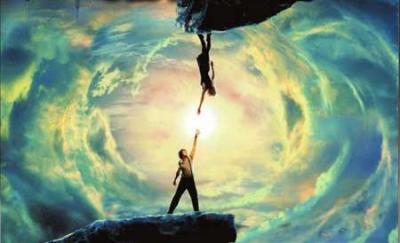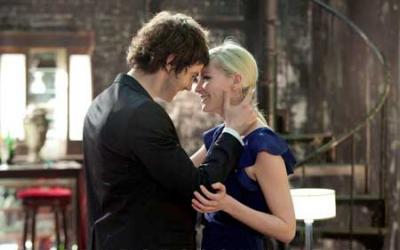By: debbie lynn elias

It takes both a visionary and visualist to create a film like UPSIDE DOWN. And that’s exactly who Juan Solanas is. A writer/director with a strong visual background in photography and art history, plus over 10 years work as a cinematographer, Solanas never ceases to amaze with his outside the box approach to life. With brilliant conceptualization from start to finish, a perfect blend of creativity, intellectual and emotional stimulation, and stunning, seemingly impossible, visuals, there is truly only one man who could breathe life into UPSIDE DOWN – Juan Solanas.
Inspired by an image in his mind’s eye of a man atop a mountain reaching towards an “upside down” world, Solanas spent 7 years creating UPSIDE DOWN. Unlike anything we have seen before, UPSIDE DOWN is a beautifully lensed blend of science fiction, drama and romance filled with social metaphor and allegory. At the film’s outset, Solanas sets the stage for us with an historical narrative, immediately bringing the audience up to speed on the world he has created. Existing within its own universe, there are two worlds that rotate side by side around the sun. The upper world (the wealthy) and the lower world (the poor), and never the twains shall meet. Employing the science of opposing gravitational fields, each world lives by its own rules and appears “upside down” to the other, with theories of inverse gravity and inverse matter coming into play throughout the story. But what happens when someone tries to cross into the other world (other than the fact that if you pull off defying inverse matter rules, you burn up in an hour)? And what happens when love enters the mix of existential and practical science?

Meeting on their respective mountaintops as children, Adam and Eden are the best of friends. Eden lives in the upper world and Adam in the lower, or opposite depending on which way you’re looking. Although they spend their youth talking to each other upside down and sharing childhood adventures in mirror fashion, and mingling worlds by way of rope climbing and other sorted measures, this childhood friendship eventually turns into love. And teens in love will not be denied. But, in the process of trying to defy the different gravities in order to be together, Eden suffers a dramatic fall when pursued by the police, trying to arrest the teens for breaking the rules and co-mingling. Watching Eden fall, presumably to her death, Adam has lost all hope in humanity, life, dreams and love. To say these two are “star-crossed” is an understatement.
Fast forward 10 years. Eden is very much alive and now working for the powerful TransWorld company whose primary business is extracting oil from the bottom half/lower world and converting it into overpriced energy to sell back to the lower world residents who, of course, can’t afford it. (Did I say this is a “futuristic” film?) But energy isn’t TransWorld’s only enterprise. Science and technology have developed so that TransWorld is able to employ residents of both the upper and lower worlds, not only to show its “fairness” but also to monopolize and control both worlds. Still believing that Eden perished in the fall 10 years ago, imagine Adam’s shock and joy when he discovers she is very much alive and working at TransWorld. Himself now a scientist, Adam knows the only way to rekindle his love is by getting into TransWorld and fine Eden. But how? It’s never been done by someone from “the lower world”. Wrangling the much needed job at TransWorld by inventing an anti-aging cream from pink bee jelly, Adam may be in the door, but not up top and must still find a way to break the gravitational barriers of the two worlds in order to gain entry into the “upper world”. The answer comes with inverse matter.
Infiltrating the “upper world”, Adam finds his beloved Eden. But she has no memory of him, their love or his world. Undeterred, Adam vows to regain her love no matter what the cost.

This is truly a love story of the universe. As Adam and Eden, Jim Sturgess and Kirsten are magical together. We see their sweet innocence grow and mature while Sturgess carries the day with earnest love and determination. Each excels at not only embracing the beauty and purity of romance in a scientific world, but also at drawing us into their worlds – the upper, the lower and “theirs”. Never getting maudlin, there is a collaborative spirit of fun and adventure that permeates the youthful period of their characters and then re-emerges in different forms 10 years later. The individual and paired performances are so emotionally authentic, one can’t help but become invested in the romance, even more than the science.
A fun touch is Timothy Spall as Adam’s Transworld “upper world” co-worker Bob. As Bob, Spall brings the enthusiasm of discovery and life that propels not only Adam, but the concept of creativity, originality, imagination and discovery. Spall’s joy and enthusiasm on screen is an infectious delight.

Written and directed by Juan Solanas, science meets existential philosophy in the creation of these parallel worlds, each filled with its own beauty and defining characteristics, but where visuals take flight are in the colorful, cloud-filled middle between the worlds with an ethereal purity of light and perfection. So powerful is the visual bandwidth that just watching UPSIDE DOWN, your own mind is turned upside down, believing that emotion and love can defy science. There are very few directors that I can even see pulling off a film like UPSIDE DOWN as it requires a very special “outside the box” form of visualization, something which is a defining characteristic of Solanas. However, even he could not have executed his visions without cinematographer Pierre Gill and VFX designer, Francois Dumoulin.
Key for Solanas was that the actors actually “act” opposite one another. Not content to use green screen and “tennis balls”, perfecting the “line of sight” was essential to the film so that not only could the actors react to each other in believable fashion, but so they would establish and maintain eye line with each other. Designing and employing a motion control method of camera operation using computer-controlled master and “robotic slave” cameras, laser beams would line up eye lines with coordinates fed by the computer to the cameras, thus mimicking perfect camera movement between the right-side up and upside down worlds, allowing POVs to vacillate between the two worlds.

Cinematography stuns on so many levels – from unique and creative camera angles to distinctive lighting that not only delineates and defines each world, but then the perfection and color and lightness of the middle space where it feels like there is no beginning and no end, but simply heavenly perfection. Color and light are magical. Celebratory is the use of backlight on Dunst through much of the film, adding an almost angelic aura to Eden. TransWorld is delicious textured white desaturation layered with super saturated icy blues. The upper world is filled with more golden sun-kissed and jewel tones. The lower world, stark, grey, saturated darkness.
Particularly effective is the POV of Sturgess’ Adam. Angling much of his story shooting from the ground up into the “upper world”, low-angle shots create a stunning panoramic cityscape vista in the sky.
Thanks to the character of Bob and Spall’s easy-going affable charm, the innovative production design of Alex McDowell allows creativity and ingenuity to take leaps and bounds in the scientific aspects of the film without shoving science down one’s throat. The character of Bob allows some important aspects of the science to easily flow.

As much as Fred Astaire dazzled the world with his “dancing on the ceiling” routine in “Royal Wedding”, Jim Sturgess goes beyond, complete with back flips, in several of his “upside down to right side up scenes” . Utilizing the same room rotation principles as in Astaire’s day, the physical execution is flawless and maintains the integrity of the gravitational differentials.
Perhaps the most stellar scene in the film involves Adam’s staying too long in the upper world and his inverse matter suit hidden under his clothing starts to burn up. Careening off a bridge into the ocean, cameras go underwater with him as he extinguishes himself and then jettisons up through two atmospheres into his world. A seemingly seamless single shot fusing character and visual spectacle, the result is stunning.
Thanks to extensive wire work for Dunst and Sturgess, not to mention the angular neck craning of looking “up” or “down” into respective worlds, given the very nature of the physical construct and design of UPSIDE DOWN, I wanted to know how much of the film’s budget went for chiropractors, something which Sturgess jokingly recalls was “not nearly enough.”

With well-defined allegory of the rich oppressing the poor and his commentary on aging, Solanas is as deliberate in his layered story design and social commentary as in his visual design. However, when it comes to his actors, improvisation plays a large part in establishing romance and authentic emotion.
One of the most original, creative and technically accomplished films of our time, UPSIDE DOWN is a pure delight. A world where dreams really can come true, where the beauty and purity of romance is juxtapositioned in the purity of science, UPSIDE DOWN is a visionary masterpiece.
Written and Directed by Juan Solanas.
Cast: Kirsten Dunst, Jim Sturgess, Timothy Spall












